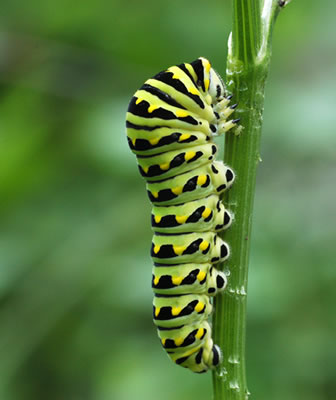Annuals
The kids have returned to school, and football fans descend on Columbia to support their teams. Even though our thoughts have turned to fall, summer is not yet over. Don’t neglect summer annuals. It’s too early yet to plant cool season annuals, since the heat will cause them to stretch and become “leggy”. High heat and humidity is typical this time of year, often a result of tropical storms during hurricane season. These can cause fungal problems, so be on the look out for gray mold or powdery mildew. Butterfly caterpillars can be found munching on food plants such as parsley, dill, fennel, Queen Anne’s lace, and other annual wildflowers. Don’t spray! Butterflies and moths are important pollinators in the ecosystem.
Turf
You may find that you need to mow more often now, thanks to beneficial rains from the tropical storms and hurricanes this time of year. Do not fertilize. Check to be sure your mower blades are in good shape and kept sharp. Dull blades can give turf diseases an opportunity to start. If you have a history of problems with fungal disease in the past with your yard, you may want to apply fungicide this fall to prevent this from reoccurring.
Perennials
Hopefully by now, you are looking at which perennials are ready to be divided. Perennials are divided for propagation, to control their size, and to invigorate them.
Older perennials that have become sparsely blooming can become more vigorous through division. A general guideline is that spring and summer blooming perennials can be divided in the fall. When dividing perennials, it is a good preventative practice to help ward off fungal diseases by making sure that shovels or garden forks are clean and sharp. A sharp tool also makes it easier on the worker to divide the plant since they don’t have to work as hard to separate the plant. Once a plant is divided, place the division into a bucket of water to keep the roots hydrated until you can get them planted. This will help to lessen transplant shock. You also need to be looking ahead. Bulbs can be planted starting next month, and you will need to have your order placed this month in time for shipping and planting. Since perennials generally go dormant during the winter, under planting the perennials with bulbs such as daffodils will make for a longer color time in planting beds. Daffodils and other bulbs co-exist easily with perennials, emerging right through the perennials’ root systems. There are generally three spring bloom times for bulbs, so careful planning can let you have bulbs in bloom anywhere from January to March. Choose fragrant varieties to plant near where people gather to sit so they can enjoy the fragrance. If squirrels are a potential threat to your bulbs, consider using a product like Perma Till to discourage them from digging up your bulbs.
Roses
If you are considering ordering roses from a catalog, place your order early. The best selections will be the first to go.
Shrubs
Little or nothing should be done to shrubs now. Make your replacement list now, and get orders together for fall replacement. I have had many homeowners experience issues with Indian Hawthorns. The shrubs became diseased and appear to be dying or looking just awful. They are suffering from a leaf disease that can be linked to overhead watering or poor pruning habits. Indian Hawthorns have been overplanted in landscapes for years. If you are looking for an easy care good alternative to Indian Hawthorns, explore the option of distyliums. They offer an assortment of mature sizes, thrive in our climate, and need very little care. In addition, they are evergreen and very disease resistant. Toward the end of the month, deciduous shrubs will start to put on their fall colors. Once leaf drop begins, be sure to keep the leaves raked out to discourage any harmful insects from being able to winter over in the debris. Don’t neglect weeding, as summer annual weeds will be dropping seed heads at this point for next year’s crop.
Trees
Fall web worms have shown up by now. While unsightly, they rarely do any major damage to trees, other than to the leaves within the webbing. You can take a “let them be” attitude, break up the nest with a stick, or prune the branch that the nest is on and dispose of it. If you break up the nest with a stick, birds will quickly find the worms and consume them, so you need not apply a pesticide. Some trees will already start showing their fall colors, soon to be followed by leaf drop. A smart way to deal with the leaves is to run a lawn mower over the leaf debris. This will shred the leaves into smaller pieces that will compost faster and add nutrients to the soil. However, you may want to first rake or blow the leaves away from the area immediately around the tree’s trunk to avoid any lawn mower damage to roots covered up by leaf debris. Never blow leaf debris into the street, as this will cause our storm drains to become clogged





